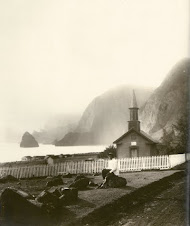
And, start I did. The initial stages of the first piece with a photo transfer onto the canvas (coated with an acrylic ground). This young man was 23 years old when this photo was taken. He was still a Brother then and it was not long before he embarked on his journey to Hawaii.

This is about more than halfway through completion.
Here is my artist statement for this project:
Where were you when you were 23 years old? What were you doing?
So many of us, even when we reach the age of 30 are not sure of what we want to do with our lives. We wait for that crystallized moment in time hoping to finally figure out why you were put on this planet to begin with. For many of us, that moment never comes with any kind of conviction or clarity and we spend most of our lives stumbling through it with a certain degree of uncertainty.
Imagine, at 23 years of age having such a strong calling to become a priest (or a vocation), that you leave your small town and family to sail halfway across the world to a place that couldn’t be any more opposite than where you came from. Talk about leaving your comfort zone! Most of us labor over trivial things such as deciding what to order off of a menu, or what to wear that day. In this day and age, people can commit to a tattoo more readily than they can a vocation.
April 15, 2009 marks a 120 years since Father Damien’s death (now Blessed Damien and soon to be St. Damien). Unless you were raised by a pack of wolves, you already know that he died of leprosy. Did you know that he was only 49 years old when he died? So very young.
Damien left Belgium to sail to Hawaii in November, 1863. He was still a Brother, not yet a priest. He was 23 years old. On March 19, 1864, he arrived in Honolulu, Hawaii. He ‘celebrated’ a birthday during that journey. I figure, that’s FOUR long months of an ocean voyage to get from point “A” to point “B”! I can’t even begin to imagine what kind of a journey that must’ve been.
Since I grew up on Molokai and lived just above the Kalaupapa Peninsula that lepers were banished to back in Damien’s day, I felt compelled to honor this man’s life work. The connection to him, for me is very strong. Until you visit this peninsula and the island, it is impossible to get a full grasp of what he accomplished. In so little time! Most people outside of Hawaii and Belgium know very little about this man’s remarkable life. I hope to at least raise the level of awareness for some of you.
When I was a teenager, Gavin Dawes published a life story on Damien, called “The Holy Man”. It was the first publication about Damien’s life. When I read this book (as a teenager), I wept. Profusely wept. I wept because it made me realize the extent of this man’s compassion and how far he was willing to go in order to make a difference in the lives of the people that were banished and abandoned to Kalawao (a district on the Kalaupapa peninsula).
On October 11, 2009, he will be canonized in Rome as a saint. Those of us from Hawaii and Belgium are quite jubilant about this (and that really is an understatement).
Creating nine pieces of art that commemorates this man’s life is a challenging project. There is only access to a limited amount of images of Damien throughout his life and everyone has seen them all. My approach is to use the images that many of us are already familiar with and give them my own twist. It is a visual outline of his life and his work. It is my hope that I impart to the viewer a greater sense of the enormity of his work.














